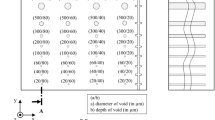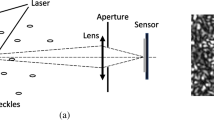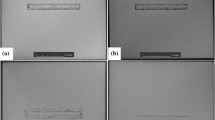Abstract
The laser additive manufacture (LAM) alloy fabrication process employs directed energy to fuse powder feedstock to produce a predetermined geometric form with unique microstructures and defects that are unlike other fabrication approaches. This study examines the efficacy for non-destructive inspection approaches to detect aberrations in bulk density (or defects) that are inherent in materials fabricated with a directed energy LAM process. Ultrasonic testing (UT) and radiographic testing (RT) are investigated for their capacity to detect seeded defects or deviations in bulk density within in LAM 300 M steel specimens. Intermittent adjustment of LAM hatch speed and hatch spacing is used to produce twelve 300 M steel specimens with bulk densities from 98 to 100%. A modified Archimedes’ method is used to measure relative (to wrought 300 M steel) bulk density. Densities from 98.22 to 99.85% were determined with a standard deviation of < 0.4% at a 95% confidence interval. UT and X-ray RT results showed clear qualitative differences between high and low-density LAM 300 M steel specimens and the full density 300 M wrought reference. UT A-Scans of LAM 300 M steel revealed multiple indications prior to and subsequent to the 1st backwall reflection and the absence of 3rd and 4th backwall reflection multiplets in LAM specimens. The UT A-scan signal amplitude threshold (with 5 and 10 MHz probes) is near 99.85% for detection of density aberrations in LAM 300 M steels. After refinement of the contrast in radiographic images, it was possible to use RT to detect defects in the specimens with bulk density up to 99.5%. Results provide insight into the development of non-destructive inspection procedures for in-situ process monitoring and qualifying parts.





Similar content being viewed by others
Data Availability
The datasets generated and/or analysed during the current study are available from the corresponding author on reasonable request.
References
Zhang, B., Li, Y., Bai, Q.: Defect formation mechanisms in selective laser melting: A review. Chin. J. Mech. Eng. 30, 515–527 (2017). https://doi.org/10.1007/s10033-017-0121-5
Sanaeia, N., Fatemia, A.: Defects in additive manufactured metals and their effect on fatigue performance: A state-of-the-art review. Prog. Mat. Sci. 117, 100724 (2021). https://doi.org/10.1016/j.pmatsci.2020.100724
Xue, L., Islam, M.U.: Free-form laser consolidation for producing metallurgically sound and functional components. J. Laser. Appl. 12, 160–165 (2000). https://doi.org/10.2351/1.521927
Vilardell, A.M., Fredriksson, G., Yadroitsev, I., Krakhmalev, P.: Fracture mechanisms in the as-built and stress-relieved laser powder bed fusion Ti6Al4V ELI alloy. Opt. Laser. Technol. 109, 608–615 (2019). https://doi.org/10.1016/j.optlastec.2018.08.042
du Plessis, A., Yadroitsav, I., Yadroitsev, I.: Effects of defects on mechanical properties in metal additive manufacturing: A review focusing on X-ray tomography insights. Mat. Design. 187, 108385 (2019). https://doi.org/10.1016/j.matdes.2019.108385
Yasa, E., Kruth, J.P.: Microstructural investigation of selective laser melting 316L stainless steel parts exposed to laser re-melting. Proc. Eng. 19, 389–395 (2011). https://doi.org/10.1016/j.proeng.2011.11.130
Waller JM, Parker BH, Hodges KL, Burke ER, Walker JL (2014) Nondestructive evaluation of additive manufacturing: State-of-the-discipline report. NASA Technical Memorandum #2014–218560, National Aeronautics and Space Administration, p. 47 Washington, (2014)
Crutzen S, Lemaitre P, Iacono I (1995) Realistic defects suitable for ISI (in service inspection) capability evaluation and qualification. In: Iida K. Light GM, Whittle MJ, (eds.). Proceedings of 14th International Conference on NDE in the Nuclear and Pressure Vessel Industries, ASM International, pp. 153–163
Farrell, S.P., Deering, J.: Analysis of seeded defects in laser additive manufactured 300M steel. J. Mat. Perf. Char. 7, 300–315 (2018). https://doi.org/10.1520/MPC20170162
Rometsch, P.A., Pelliccia, D., Tomus, D., Wu, X.: Evaluation of polychromatic X-ray radiography defect detection limits in a sample fabricated from Hastelloy X by selective laser melting. NDT. E. Inter. 62, 184–192 (2014). https://doi.org/10.1016/j.ndteint.2013.12.014
Consonni, M., Howse, D., Wee, C.F., Schneider, C.: Production of joints welded with realistic defects. Weld Int 28, 535–546 (2013). https://doi.org/10.1080/09507116.2012.753263
Sharratt B (2015) Non-destructive techniques and technologies for qualification of additive manufactured parts and processes: A literature review. Contract Report # DRDC-RDDC-2015-C035, Defence Research and Development Canada, Halifax NS, p. 47
Lindgren E (2018) In-situ X-ray radiographic quality control of 3D printed metal components. Technical Report # KIMAB-2018-601, Research Institute Swerea KIMAB, Sweden, p. 50
Galleguillos C, Periñán A, Lasagni F (2018) Analysis and development of inspection procedures based on X-ray computed tomography and digital radiography on aerospace additive manufactured parts. Proceedings of 12th European Conference on Non-Destructive Testing, Gothenburg, Sweden, p. 4. http://www.ndt.net/?id=22941
NDT Resource Center. Introduction to radiographic testing. https://www.nde-ed.org/EducationResources/CommunityCollege/Radiography/cc_rad_index.htm. 2020 Accessed 13 Aug 2020.
Slotwinski, J.A., Garboczi, E.J.: Porosity of additive manufacturing parts for process monitoring. AIP. Conf. Proc. 1581, 1197–1204 (2004). https://doi.org/10.1063/1.4864957
Xue, L., Li, Y., Wang, S.: Direct manufacturing of net-shape functional components/test-pieces for aerospace, automotive and other applications. J. Laser. Appl. 23, 042004 (2011). https://doi.org/10.2351/1.3622200
Slotwinski, J.A., Garboczi, E.J., Heberstreit, K.M.: Porosity measurements and analysis for metal additive manufacturing process control. J. Res. Nat. Inst. Stand. Technol. 119, 494–528 (2014). https://doi.org/10.6028/jres.119.019
Ahsan, M.N., Bradley, R., Pinkerton, A.J.: Microcomputed tomography analysis of intralayer porosity generation in laser direct metal deposition and its causes. J. Laser. Appl. 23, 022009 (2011). https://doi.org/10.2351/1.3582311
Spierings, A.B., Schneider, M., Eggenberger, R.: Comparison of density measurement techniques for additive manufactured metallic parts. Rapid Prototyp J 17, 380–386 (2011). https://doi.org/10.1108/13552541111156504
ASTM B311-17. Standard test method for density of powder metallurgy (PM) materials containing less than two percent porosity (2017). ASTM International, West Conshohocken, PA. www.astm.org
ASTM B962-17. Standard test method for density of compacted or sintered powder metallurgy (PM) products using Archimedes’ principle (2017). ASTM International, West Conshohocken, PA. www.astm.org
ASTM E178-16. Standard practice for dealing with outlying observations (2016). ASTM International, West Conshohocken, PA. www.astm.org
Acknowledgements
The authors would like to thank Dr. Xue of the National Research Council of Canada for specimen fabrication and Mr. Deering, Mrs. Hervé, Mr. Avery and Mr. Sanford from Defence Research and Development Canada for their assistance in preparing and testing specimens. This research was funded by the Canadian Federal Government through the Department of National Defence and the Department of Natural Resources Canada.
Funding
This research was funded by the Canadian Federal Government through the Department of National Defence and the Department of Natural Resources Canada.
Author information
Authors and Affiliations
Corresponding author
Ethics declarations
Conflict of interest
The author has no conflicts of interest to declare that are relevant to the content of this article.
Ethical Approval
Results reported in this manuscript are original and that all the data given in the article are real and authentic; outcomes are novel and were not published in the open literature before.
Consent to Participate
The authors confirm that the manuscript, and its parts, has not been published before, nor under consideration for publication anywhere else. Submission of this manuscript has been approved by the responsible authorities at the publishing office of Defence Research and Development Canada.
Consent for Publication
The manuscript is Crown Copyright and a signed Springer copyright consent form will be made available.
Additional information
Publisher's Note
Springer Nature remains neutral with regard to jurisdictional claims in published maps and institutional affiliations.
Rights and permissions
About this article
Cite this article
Farrell, S.P. Detection of Aberrations in Bulk Density in Additive Manufactured 300 M Steel using X-ray Radiographic Testing and Ultrasonic Testing. J Nondestruct Eval 40, 84 (2021). https://doi.org/10.1007/s10921-021-00814-5
Received:
Accepted:
Published:
DOI: https://doi.org/10.1007/s10921-021-00814-5




